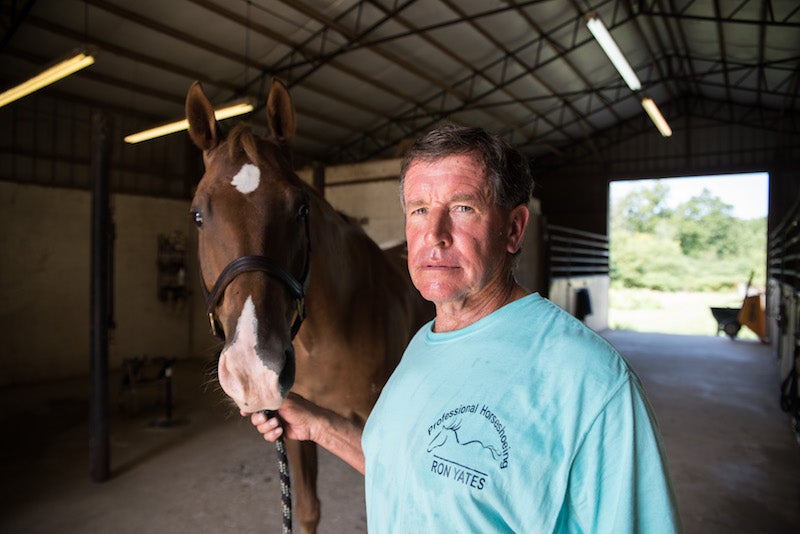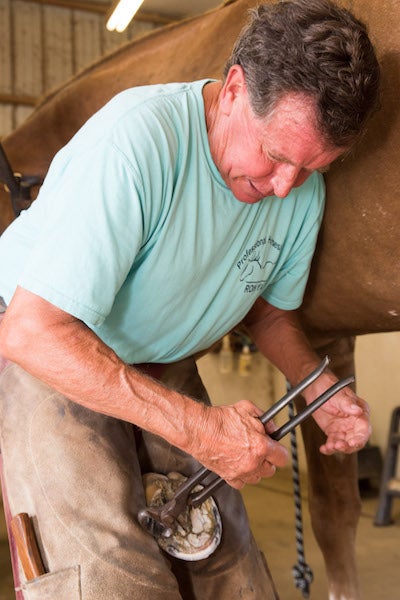
Story by JOYANNA LOVE
Photos by KEITH MCCOY
A good reputation is important for anyone who owns their own business. For Ron Yates, it was the only way people would trust him with their expensive show horses.
Yates has been shoeing horses for 47 years. Word of mouth of his good work has gained him 70 to 80 regular customers.
However, Yates had to work hard to establish the reputation that has gained him this loyal customer base.
“When you first start out, you have to take what you can get,” Yates said. “You get donkeys and things that want to kill you. You gotta start there.”
Yates first started riding horses at the age of 14.
“My daddy retired from the Air Force, so we didn’t get to have horses much until we moved here to the South,” Yates said.
The family had moved to Prattville where Yates attended high school. He has lived in Chilton County for about 40 years now.
His interest in becoming a farrier was partially based in necessity.
“I could never get anyone to shoe my horses,” Yates said. “I was going to University of Alabama, so I went to horseshoeing school in the summer.”
Yates traveled to Oklahoma for two months of training.
“The first two weeks I was there, if I could have gotten my money back I would have come home,” Yates said. “I thought I was going to die — my legs, my back. I never had done anything like that. I looked at the other people and they were kind of in the same situation, then after about two weeks, you kind of got used to the positions.”
Several in the class did quit.
On top of learning how to correctly put a horseshoe on a horse, Yates and the other students were required to create all of their own horseshoes from a straight piece of steel. Students used coal forges to heat the metal, making it soft enough to hammer into shape.
“I was the youngest one in the school,” Yates said. “I was 18.”
Today, Yates works mostly with purchased aluminum shoes that he can widen to the correct shape with less time at the anvil.
The shoes come in about 20 different sizes. Each shoe has to be modified to fit the specific horse. A horse needs new shoes on average every six weeks because a horse’s hooves grow in a similar fashion as a person’s fingernails. All four shoes are changed at the same time.
“It is a very repetitive business,” Yates said.
Yates also has a mini-gas forge in his work truck in case there is ever a shoe he needs to do specialized work on.
Since he had graduated early from high school, Yates was in his junior year of college when he decided to pursue a career shoeing horses.
He had been attending the University of Alabama on an academic scholarship as a psychology major.
Having this base level knowledge of psychology has come in handy when working with customers, Yates said.
Yates had his own business at the age of 19.
“My parents were aggravated because I had a scholarship, but I just didn’t want to go do it (attend college) anymore once I started doing this,” Yates said. “I have been very fortunate that it has worked out good for me.”

Once he started horseshoeing, he started getting calls from people wanting him to come put shoes on their horses.
Yates did some advertising to get his name out in the very beginning, but most of his business has come from the recommendations of customers.
“There are all kinds of horses,” Yates said. “I kind of targeted the show horse crowd … I do mostly the quarter horses and the ones that show.”
Yates said there are more quarter horses in Alabama than other horse breeds, so more business is available.
“I have a lot of good costumers,” Yates said.
Yates said it is the people and the horses that have kept him in the industry so long.
“I love a good horse, and you meet a lot of nice people,” Yates said.
Yates said building a good customer base was the hardest part of the job. Developing a reputation for doing a good job was essential to staying in the business and getting to work with good horses.
“Some of these horses are $50-100 thousand,” Yates said.
News of someone that crippled a horse by making a mistake “spreads like wildfire” among the horse show community, Yates said.
Yates said the key to being successful was “doing a good job, show up on time.”
“Being self-employed takes more discipline than when you’ve got an 8-5 job,” Yates said.
He said if someone does a good job, the customer will likely call them back.
Most customers have more than one horse that needs shoeing at a time.
All of the equipment Yates needs fits in the back of his truck, so he can drive to his customers.
Yates said few of his clients come to him.
“I have a handful of people that come here,” Yates said. “They might be 100 miles off or something … they find it better just to come here.”
The process of putting new shoes on a horse starts with removing the old one, cleaning the area and shaving it down.
“A lot of people always want to know does it hurt them,” Yates said. “This is all dead tissue.”
He said if a horse’s hoof is trimmed and not re-shoed, the tissue will eventually wear off, but once a shoe is in place, it just keeps growing.
There is a narrow area around the hoof where the nails can be driven in without hurting the horse.
The nails used are made specifically for horseshoes.
“I typically just use six nails, three on each side,” Yates said.
The modern horseshoes have several holes in them giving the farrier the chance to see where would be best to place the nails to keep the shoe in place.
Aluminum shoes are used for show horses.
Steel shoes are used for horses that do roping and barrel racing.
“It’s kind of like wearing tennis shoes (aluminum) as opposed to work boots (steel),” Yates said.
Despite the dangers of the job, Yates said he has never been seriously hurt while shoeing horses. Although he said he does have some scars from the nails going through his chaps.
Yates said the horse’s owner is on hand during the shoeing almost every time to keep the horse calm.
While a few people have taken up horseshoeing as a profession because of Yates, he said it is something that not many young people are doing.
“It would be a pretty good profession for somebody. You have to be used to horses … and willing to work,” Yates said. “Most people when they start out they work with an established person.”
Yates owns three horses of his own. He said he used to raise horses and show them across the South.
“When I first started shoeing, I was training horses on the side until I got my costumers built up,” Yates said. “Once I got my customers built up, I quit training.”
He also helps judge local horse shows.
